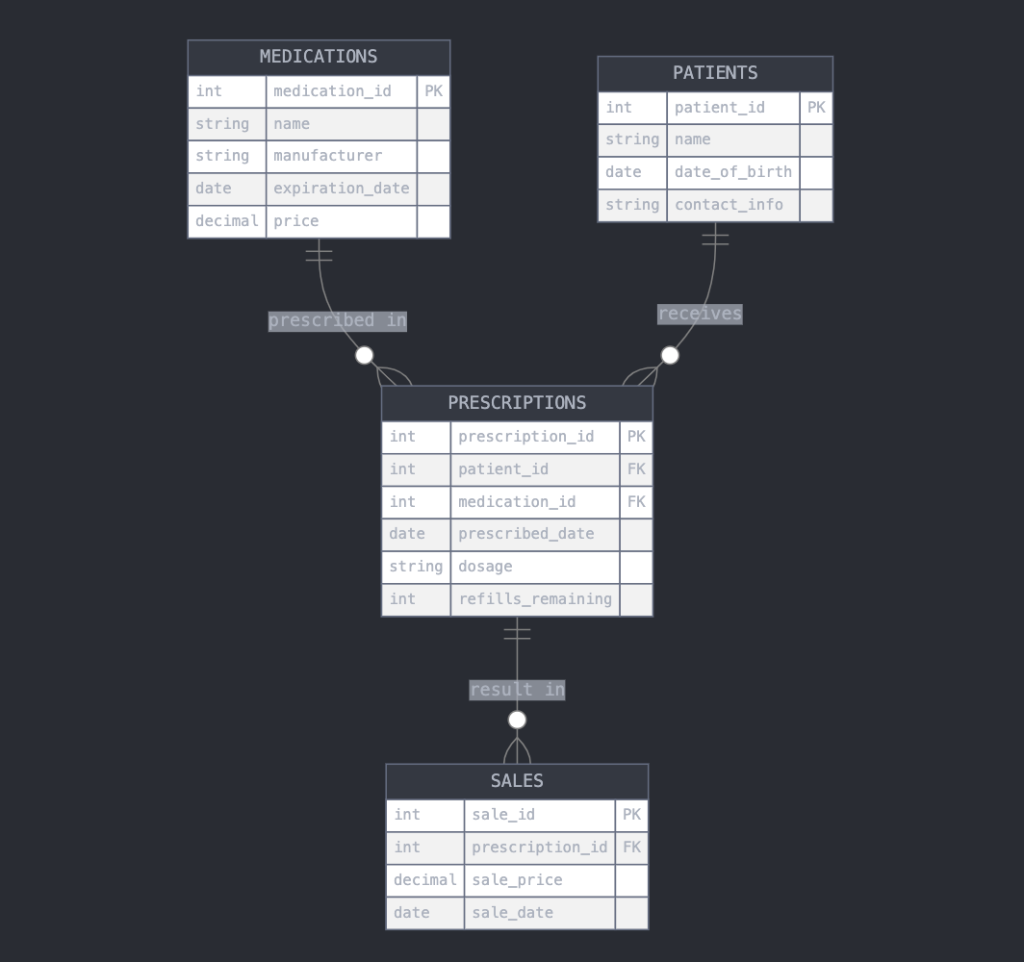Create a Pharmacy Database In 3 Steps
Build a Professional Pharmacy Database – In Just 3 Steps
Managing prescriptions, tracking inventory, and handling pharmacy-related tasks can be challenging without a structured system in place. This is where a pharmacy database comes in handy. It stores essential information about medications, patient details, prescription history, and more in an intuitive and secure web interface.
Whether you’re a pharmacist or part of a team responsible for managing medications and patient records, having a robust pharmacy database can make things easier. Let’s dive in and learn how to create a pharmacy database that suits your pharmacy’s needs.
Explore Our Comprehensive Pharmacy Database
Our comprehensive Pharmacy Database helps you manage patient records, medication inventory, prescription tracking, and dispensing history all in one intuitive system.
Why Build a Pharmacy Database?
A well-organized pharmacy database is essential for pharmacy operations. It helps you:
✅ Track medication inventory and prescription history: Know what medications are in stock, who the patients are, and the history of each prescription.
✅ Manage pricing and sales: Keep track of medication pricing, sales history, and patient billing information.
✅ Handle prescriptions and patient relations: Efficiently manage incoming prescriptions, patient records, and ensure all details are correctly recorded.
✅ Monitor medication expiration and compliance: Track medication expiration dates, regulatory compliance, and any necessary restocking efforts.
Having all your pharmacy information in one place ensures that your team is on the same page, allowing for more efficient management of your inventory and a better experience for your patients.
What Is a Pharmacy Database?
A pharmacy database stores detailed information about your medications and patient records, including medication names, dosages, pricing, prescription history, and sales records. It also tracks inventory levels, patient prescriptions, and compliance with regulatory requirements.
Depending on your pharmacy’s needs, you might also track attributes like expiration dates, patient allergies, and refill schedules. Additionally, you can monitor patient interactions, pharmacy events, and any specific compliance requirements (e.g., “controlled substances documentation required,” “insurance verification records”). It can even integrate with your Point of Sale (POS) system, ensuring your actual and recorded sales are always in sync.
Let’s say you are managing a pharmacy. Your main system might handle the basics, like tracking sales and prescription fulfillment. But it might not be great at keeping track of all the finer details, such as medication inventory, patient history, or compliance with regulations.
That’s where a proper pharmacy database comes in handy. It’s like a one-stop shop for everything about your medications and pharmacy processes. You can search it easily, and it keeps all the important info in one secure place. This makes it much easier to manage your pharmacy and ensure the smooth operation of prescriptions and patient care.
Why Spreadsheets Fall Short for Pharmacy Databases
Let’s face it, many pharmacies start out tracking their inventory and prescriptions in Excel or Google Sheets. It seems easy at first, especially when your operation is small. But as your pharmacy grows, these spreadsheets can cause some real headaches:
❌ Version Chaos: Before you know it, everyone’s got their own copy. You end up with a mess of files like “MedicationInventory_LATEST,” “Prescriptions_Updated,” “OldRecords_Ignore,” and so on. Who knows which one’s right?
❌ No Clear History: Without a proper system, it’s hard to keep track of who changed what and when. If the person in charge of updates leaves, you might be left wondering why certain changes were made. Worse, if you need to check a patient’s prescription history, you may not be able to find all the data. With a properly structured database, you don’t have to worry about any of these issues.
❌ Data Gets Messy: People start adding their own notes, highlighting things, and making manual tweaks to Excel spreadsheets. Soon enough, you’ve got a rainbow of colors and comments that don’t make sense to anyone else. For example, someone might mark a medication as “out of stock” in one file, but others might miss it or misunderstand.
Using spreadsheets for your pharmacy data goes against the whole point of having one trustworthy source of information. Instead of smoothly managing your inventory and prescriptions, you end up playing detective with a bunch of conflicting spreadsheets.
Building a Real Pharmacy Database
Building a real pharmacy database with a proper tool can solve these problems. It gives you one central place for all your pharmacy information that everyone can rely on. This ensures smoother operations, better inventory management, and a more efficient pharmacy system.
How to Create a Pharmacy Database in 3 Steps
Let’s be real—if you’re managing a pharmacy, you probably don’t have time to become a database expert. You are day-to-day business is keeping you busy enough, and creating an entire database from scratch is not something you can easily carve out time for. Normally, to create a custom database, you would need to fully understand concepts like SQL and how to build user interfaces. That’s a lot to ask when you’re busy overseeing prescriptions, sales, and patient relations.
This is why many pharmacies put off creating a proper pharmacy database and run with older systems or use systems that don’t meet their needs 100%. Finding an alternative just seems too complicated and time-consuming.
But here’s where tools like Five come in handy. It’s an online database builder that makes creating a pharmacy database much simpler.
First up, our ready-to-use pharmacy database comes with all the essential features, such as medicine, inventory and prescription management.
Beyond its out-of-the-box features, our pharmacy database is also fully expandable. So, in short, Fives gives you the ability to:
✅ Quickly Set Up Your Pharmacy Database
Sign up for our ready-to-use pharmacy database and get a user-friendly interface without any extra work. You can also easily bring in your existing data from Excel or other spreadsheets, so you don’t have to start from scratch.
✅ Add Custom Features
Every pharmacy operates a little differently or has its own unique requirements for data storage, retrieval and reporting. With Five, you can add any kind of enhancement to the pharmacy database. For example, you can create detailed reports about prescriptions, sales, and patient relations, or set up charts to help you visualize your data at a glance. One of the most useful features is the ability to set up alerts for important dates like prescription refills, medication restocks, or compliance checks.
✅ Access Your Database From Any Device
Whether you’re in the pharmacy or working remotely, you can always access and manage your pharmacy data securely.
With Five’s intuitive pharmacy database, managing your pharmacy data becomes simple and efficient, allowing you to focus on what matters most—providing excellent patient care and managing your pharmacy smoothly.
With your pharmacy database in place, here are three simple steps you can take to enhance and customize it.
Step 1: Access the Free Preview of the Pharmacy Database
Step 1 is all about exploration. So, first, sign up for a free preview of the pharmacy database and take time to explore its features. With the free preview, you get immediate access to:
✅ A fully functional, cloud-based pharmacy database with prefilled sample data
✅ Built-in medicine, patient or prescription search features
✅ Secure user authentication and data management
Our prebuilt database contains the most important fields, such as
✅ Medicine name
✅ Medicine supplier
✅ Side effects
✅ Dosis
✅ Storage Conditions
✅ Generic Medicine Names
✅ Inventory Levels and Restocking Alerts
✅ Contact Information for Patients and Providers
In step 2, we map out enhancement and customizations.
Step 2: Expand Your Pharmacy Database
Here are two good ways to approach this second step of mapping out enhancements:
1️⃣ Ask What Matters Most To Your Pharmacy?
What do your pharmacists, patients, technicians, and staff care about? You want your pharmacy database to be the go-to place for all this information, so make it as comprehensive as possible.
2️⃣ Think About How You Manage Your Pharmacy Operations
Your pharmacy database isn’t just a list—it’s a tool that should help you manage your operations day-to-day.
Consider tracking:
▶️ Medication Lifecycle: Record key milestones such as acquisitions, expiration dates, and restocking efforts.
▶️ Prescription Management: Keep notes on prescription schedules, patient preferences, and any special requirements.
▶️ Compliance and Legal Requirements: Monitor compliance with regulations, track documentation for controlled substances, and ensure all necessary records are up-to-date.
▶️ Sales and Pricing Management: Track medication pricing, sales history, and patient transactions to ensure accurate financial records.
▶️ Patient Relations and Communication: Collect and manage information on patients, their prescriptions, and their interactions with your pharmacy.
The more detailed your records, the more valuable your database will become. For example, if you want to analyze prescription trends, ensure compliance with regulatory requirements, or manage patient relations effectively, you’ll need to have been recording that data consistently.
Remember, a good pharmacy database evolves with your pharmacy’s needs. Start with the essentials, and you can always add more detail as your operations grow.
Step 3: Enhance and Customize the Product Database
With your prioritized list from Step 2, you’re ready to tailor the database to your exact requirements. Begin with the essential must-have features that will deliver immediate operational benefits to your pharmacy.
By using our pre-built database as a foundation, you can rapidly add new features, such as:
✅ Custom dashboards for tracking sales, medicines or prescriptions
✅ Custom reports for weekly, monthly or quarterly reporting
✅ Custom user roles for internal staff, suppliers or customers
✅ Integrations with your point of sale systems for accurate inventory management
✅ Custom alerts to avoid stockouts or to inform customers that a medicine is ready for pickup
The Pharmacy Database Schema
If – rather than starting with a prebuilt application, you’d still like to build a pharmacy database from scratch, there is a simple database schema to help you get started.
This schema contains four related tables:
1️⃣ Medications Table: At the core of the database, this table stores information about each medication, such as name, manufacturer, expiration date, and pricing.
2️⃣ Patients Table: This table helps classify prescriptions by patient, making it easier to organize and retrieve records based on patient history or medication.
3️⃣ Prescriptions Table: A critical component of the schema, this table links medications to their prescription records, allowing you to track prescription history and current status.
4️⃣ Sales Table: This table tracks medication sales, pricing, and patient transactions.
Each table holds specific information, such as medication details, prescription records, and sales data, ensuring a comprehensive and organized structure. The relationships between these tables facilitate efficient pharmacy management, making it easier to track medication progress, manage sales, and provide an optimal experience for your patients and staff.

Remember, our prebuilt pharmacy database application has all of these fields, as well as many more, preconfigured, so that you don’t have to reinvent the wheel and start from scratch.
Pharmacy Database: Key Features
Last, let’s explore some of the key features of our application:
A Customizable Pharmacy Database
You can transform the prebuilt pharmacy database by configuring its database tables and field definitions. Add as many fields as you need to your pharmacy database, ensuring it meets the specific requirements of your pharmacy, whether it’s tracking medication details, prescription history, or sales records.
Simple-to-Use Forms
The pharmacy database comes with preconfigured, simple-to-use forms, making it easy to enter and manage data. These forms enable you to store or retrieve information, such as medication details or prescription schedules. Additionally, you can create charts, dashboards, or even PDF reports, perfect for generating sales summaries, inventory reports, or patient profiles.
Login Protected and Secure
Securing your pharmacy data is crucial. Five’s database comes with a pre-built authentication and login screen. Only registered users with valid credentials can view or edit data. You can also enable multi-factor authentication for extra security, ensuring that your pharmacy data remains protected and accessible only to authorized personnel.
Generate Documents
Five allows you to generate PDF documents directly within the application. You can easily print prescriptions, sales reports, inventory catalogs, or patient agreements and build workflows for approval or distribution, streamlining your pharmacy management process.
Searchable and Online
Your pharmacy database is searchable and hosted online, making it accessible from any device at any time. This ensures that your pharmacy team can stay connected and up-to-date on medication data and operations, whether they’re in the pharmacy or working remotely.
Get Started with Five Today
To build your pharmacy database with Five, sign up for a free preview of our ready-to-use system. Map out required enhancements from there. If you need assistance, visit our forum to get help from our application development experts as you add more features to your database application.
By following the steps mentioned above, you can create pharmacy management software tailored to your needs!


